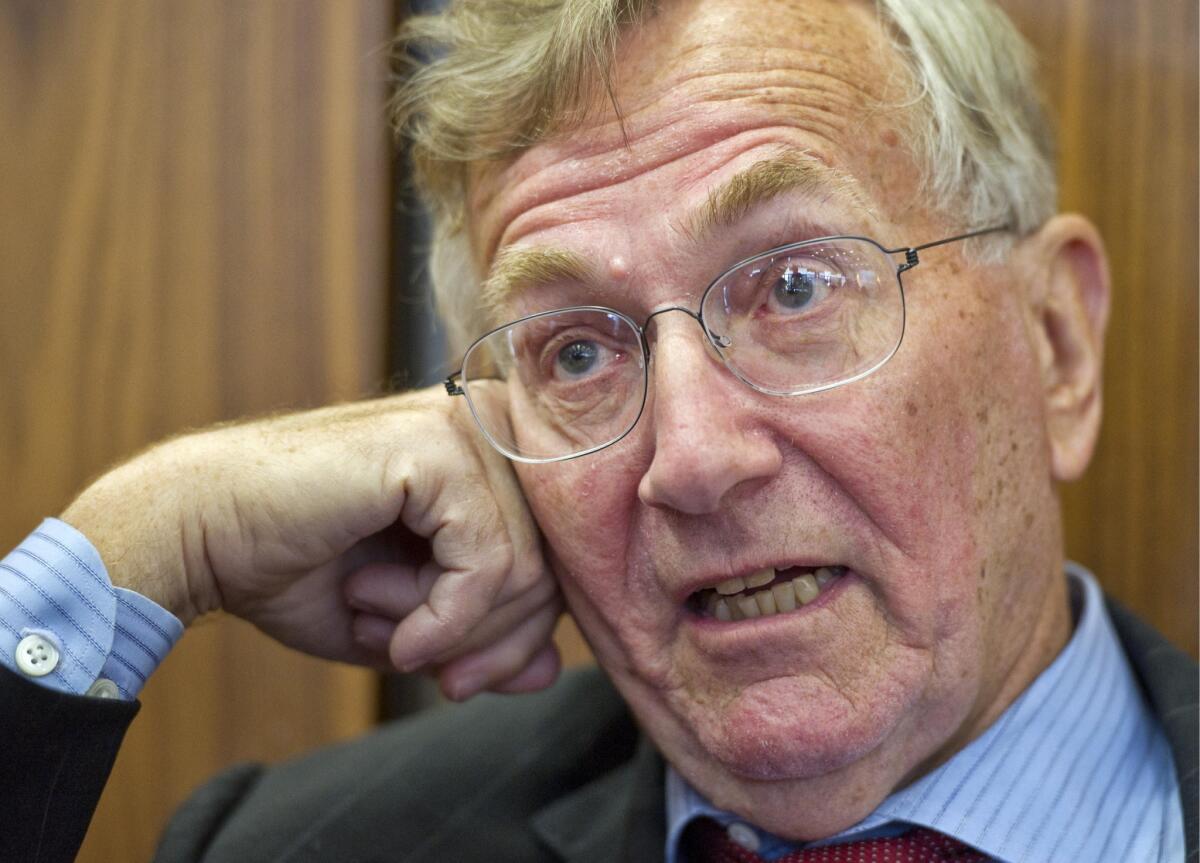Review: ‘The Killing of Osama Bin Laden’ by Seymour Hersh details a grave threat to our democracy
Governments, in order to fulfill their national security objectives, must sometimes shroud their activities in secrecy. This is regrettable, if inevitable. But secrecy can also be employed as a kind of intellectual asphyxiant, used to choke off a population’s interrogational faculties by depriving it of the capacity to make informed judgments about its government’s short-term activities and long-term aims. “Secrecy is a form of regulation,” wrote Daniel Patrick Moynihan in 1998. “At times, in the name of national security, secrecy has put that very security in harm’s way.”
It is the demands of state secrecy, their distressing effects on U.S. foreign policy — and ultimately their subversion of the democratic process — that unify the four essays in Seymour Hersh’s “The Killing of Osama Bin Laden,” all of which were previously published in the London Review of Books. In the book, Hersh, an indefatigable investigative reporter (he broke the story of the My Lai massacre in 1969; the CIA domestic-spying scandal in 1974; and the torture scandal at Abu Ghraib prison in Iraq in 2004), documents a series of covert operations — and their sometimes-unforeseen repercussions — carried out in Syria, Libya and Pakistan by the United States and its allies during the Obama administration.
Hersh leans heavily on anonymous sources in his reportage. This is understandable, given his subject matter, but how you read the book will depend on the faith you place in these sources and in Hersh’s own judgment about their veracity. I think the record here is mixed, at best.
Consider, for instance, Hersh’s reporting on the war in Syria, which dominates three of the four chapters. (The book’s title is thus a bit of a misnomer.) Hersh argues that the nerve gas attacks in the Damascus suburb of Ghouta in 2013 were not perpetrated by Assad’s forces but by the Al Nusra Front, an Al Qaeda affiliate. According to Hersh, Al Nusra was directly assisted by the Turkish government, which believed that a chemical weapons attack traced to Assad — even if it was actually committed by agents provocateurs — would force the Obama administration to enter the war against the Syrian government.
The Ghouta attacks led President Obama to threaten military action against the Assad regime, as he had previously asserted that the use of such weapons would constitute a “red line” potentially precipitating intervention. Hersh claims that Obama reversed course in the face of mounting classified evidence casting doubt on Assad’s culpability, as well as resistance from the Joint Chiefs, who feared a spiraling regional conflict. (Throughout the book, military and Defense officials often appear wiser and more deliberative than the CIA leadership and other senior Obama administration officials, raising questions about source bias and interservice rivalry.)
In any case, this is an explosive account. The sarin attacks in Ghouta killed hundreds of civilians, including many children. They were war crimes. If, as Hersh claims, the Turkish government aided an Al Qaeda affiliate in procuring and employing chemical weapons in order to goad the U.S. into open warfare against the Assad regime, it could seriously damage our alliance with Turkey, a crucial NATO ally.
But there are important questions regarding the plausibility of this story. For one, providing the Al Nusra Front with chemical weapons would be an extraordinarily dangerous gambit. Would the Erdogan government risk further destabilization and mass displacement on its own southern border in the hope that the Obama administration might follow through on its threats and enter the war because of a sarin attack? And, moreover, would Turkey really risk the proliferation of chemical weapons to terrorist groups — weapons that might be used one day on Turkish troops or civilians or be traced back to Turkish sources?

Investigative reporter Seymour Hersh.
Hersh may also be underestimating the Assad regime’s interests and capabilities, as well as its propensity for brutality. The attacks took place in a rebel-controlled area. Assad was widely known to possess chemical weapons at the time of the Ghouta attacks; indeed, Syria was one of the few countries in the world that refused to accede to the Chemical Weapons Convention. It had used chemical weapons during the conflict, and has since. Moreover, expert analyses conducted jointly by the Organization for the Prohibition of Chemical Weapons and the United Nations, and separately by Human Rights Watch, conclude that the rocket was almost certainly launched from regime-held territory. And the rockets used in the attack — Russian in origin — had been employed by government forces previously during the conflict.
Hersh’s dubious claims about the Ghouta attacks aside, however, I am sympathetic to his skeptical view of events in the wider Middle East, where our allies have a tendency to simultaneously cooperate with us and actively subvert our interests — to play a double or even triple game. And no two states better exemplify this behavior than Pakistan and Saudi Arabia. (Proving that Tolstoy’s dictum applies as well to international affairs as it does to interpersonal relations, our relationship to both states is clearly “unhappy in its own way.”) In the book’s namesake essay, “The Killing of Osama Bin Laden,” we get a better sense of how these relationships, especially the American-Pakistani dynamic, play out.
Relying heavily on a single unnamed “retired senior intelligence official,” Hersh reports that, in contrast to the Obama administration’s account, Bin Laden’s whereabouts were revealed to the U.S. through a “walk-in,” that is, a senior Pakistani military official who, desirous of the $25-million reward on Bin Laden’s head, contacted the CIA. (Carlotta Gall and Steve Coll, both highly respected investigative journalists, say their own reporting corroborates, to various degrees, Hersh’s account here.)
Moreover — and again in contradiction to the Obama administration — Hersh reports that Bin Laden had been in the custody of the ISI, Pakistan’s intelligence service, since 2005, and that the Pakistani military was fully aware of his location in Abbottabad, Pakistan; that his housing and care were being paid for by the Saudis; and that, once Bin Laden’s location was revealed to the U.S., the Pakistani military had agreed to let American special forces raid the house in Abbottabad with the explicit understanding that Bin Laden was to be assassinated.
Americans were also supposed to delay announcing that Bin Laden had been killed for a few weeks and claim that he died in a firefight on the Afghan side of the mountainous Afghan-Pakistan border. Hersh claims that Obama administration officials were so worried about leaks, and so eager to cash in politically, that they reneged on their prior promises to the Pakistanis and disclosed the true location of the raid almost immediately.
Copious amounts of ink have been spilled on Hersh’s Bin Laden piece, but much of the coverage has focused on gaps in specific parts of Hersh’s story. This, I think, has been at the expense of examining whether the broader pattern of behaviors and relationships Hersh describes fit a plausible historical pattern, which lends credence — if not absolute credibility — to his account.
Take the decades-old relationship among the American, Pakistani and Saudi intelligence agencies, which cooperated extensively during the anti-Soviet jihad in the 1980s that gave birth to Al Qaeda and the Taliban. During this period, the Saudis had significant excess financing but little expertise in intelligence work or covert operations, so they outsourced their operations in the region to the ISI. The ISI also worked closely with the CIA on organizing the mujahedin against the Soviets.
But the Pakistanis and Saudis coordinated on initiatives parallel to, and without the knowledge of, the CIA, empowering the most fanatical elements in the region. At this time, Bin Laden was not the world’s most-wanted terrorist: He was a major financial sponsor of other jihadists in the region and the scion of one of the Saudi kingdom’s most powerful families.
Abbottabad, where Bin Laden was killed, is a wealthy resort town a mere half-mile from Pakistan’s military academy and near an ISI base. Although the government denies foreknowledge of Bin Laden’s whereabouts, it simply beggars belief that the Pakistani military and intelligence establishment was not aware of his presence. (For its part, the Obama administration does not seem particularly motivated to pursue this issue publicly. Imagine, by way of contrast, what the U.S. reaction would have been if Bin Laden were found living in a posh neighborhood in Tehran.)
As Hersh notes, Pakistan and Saudi Arabia had good reasons to keep Bin Laden in custody and his captivity hidden from the United States. Pakistan could use Bin Laden as leverage on jihadists — who, Pakistan wagered, would keep quiet about the situation — it wished to control. These groups could then be occasionally unleashed on India, especially in the disputed Kashmir region, as well as in Afghanistan, in order to keep that country pliant and out of India’s sphere of influence. This arrangement would also allow the Saudis to manage the quiet, comfortable isolation of its wayward son, ensuring that he wouldn’t be captured by Americans, who might ask some very uncomfortable questions about Saudi support for terrorism worldwide.
It is doubtful if we’ll ever know about whether such an arrangement existed. Bin Laden was killed, perhaps illegally, in the raid. The circumstances surrounding his captivity are still extraordinarily murky. Nearly five years later, the U.S. and Pakistan still remain locked in an unhappy marriage with no short-term prospects for divorce. Pakistan still supports terrorist organizations in Kashmir (such as Lashkar-e-Taiba) and in Afghanistan (such as certain Taliban factions), destabilizing two very dangerous borders. But we depend on — obviously partial — cooperation by Pakistan on intelligence-sharing and counterterrorism matters. U.S. officials, rightly worried about the security of Pakistan’s growing nuclear-weapons arsenal, would also rather keep a duplicitous ally close than lose whatever access they currently possess.
The demands of realpolitik might counsel the U.S. to continue to pursue the same web of shaky alliances that has defined its position in the wider Middle East for decades. But if the American people aren’t provided with at least an approximate story of our allies’ activities and objectives — not to mention our own — we cannot make informed judgments about who our allies truly are, or reasoned critiques about the overall coherence of our country’s foreign policy. That, above all, is the danger of a regime of excessive secrecy in international affairs. Whatever his interpretive excesses and inductive leaps, it is a danger of which Hersh is rightly and acutely aware.
Dorfman is a senior fellow at the Carnegie Council for Ethics in International Affairs.
::
“The Killing of Osama Bin Laden”
Seymour Hersh
Verso: 144 pp., $19.95
More to Read
Sign up for our Book Club newsletter
Get the latest news, events and more from the Los Angeles Times Book Club, and help us get L.A. reading and talking.
You may occasionally receive promotional content from the Los Angeles Times.






